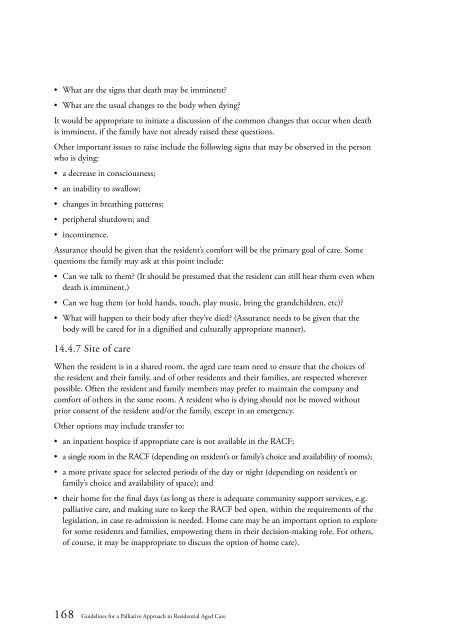Guidelines for a Palliative Approach in Residential Aged Care
Guidelines for a Palliative Approach in Residential Aged Care
Guidelines for a Palliative Approach in Residential Aged Care
You also want an ePaper? Increase the reach of your titles
YUMPU automatically turns print PDFs into web optimized ePapers that Google loves.
• What are the signs that death may be imm<strong>in</strong>ent?<br />
• What are the usual changes to the body when dy<strong>in</strong>g?<br />
It would be appropriate to <strong>in</strong>itiate a discussion of the common changes that occur when death<br />
is imm<strong>in</strong>ent, if the family have not already raised these questions.<br />
Other important issues to raise <strong>in</strong>clude the follow<strong>in</strong>g signs that may be observed <strong>in</strong> the person<br />
who is dy<strong>in</strong>g:<br />
• a decrease <strong>in</strong> consciousness;<br />
• an <strong>in</strong>ability to swallow;<br />
• changes <strong>in</strong> breath<strong>in</strong>g patterns;<br />
• peripheral shutdown; and<br />
• <strong>in</strong>cont<strong>in</strong>ence.<br />
Assurance should be given that the resident’s com<strong>for</strong>t will be the primary goal of care. Some<br />
questions the family may ask at this po<strong>in</strong>t <strong>in</strong>clude:<br />
• Can we talk to them? (It should be presumed that the resident can still hear them even when<br />
death is imm<strong>in</strong>ent.)<br />
• Can we hug them (or hold hands, touch, play music, br<strong>in</strong>g the grandchildren, etc)?<br />
• What will happen to their body after they’ve died? (Assurance needs to be given that the<br />
body will be cared <strong>for</strong> <strong>in</strong> a dignified and culturally appropriate manner).<br />
14.4.7 Site of care<br />
When the resident is <strong>in</strong> a shared room, the aged care team need to ensure that the choices of<br />
the resident and their family, and of other residents and their families, are respected wherever<br />
possible. Often the resident and family members may prefer to ma<strong>in</strong>ta<strong>in</strong> the company and<br />
com<strong>for</strong>t of others <strong>in</strong> the same room. A resident who is dy<strong>in</strong>g should not be moved without<br />
prior consent of the resident and/or the family, except <strong>in</strong> an emergency.<br />
Other options may <strong>in</strong>clude transfer to:<br />
• an <strong>in</strong>patient hospice if appropriate care is not available <strong>in</strong> the RACF;<br />
• a s<strong>in</strong>gle room <strong>in</strong> the RACF (depend<strong>in</strong>g on resident’s or family’s choice and availability of rooms);<br />
• a more private space <strong>for</strong> selected periods of the day or night (depend<strong>in</strong>g on resident’s or<br />
family’s choice and availability of space); and<br />
• their home <strong>for</strong> the f<strong>in</strong>al days (as long as there is adequate community support services, e.g.<br />
palliative care, and mak<strong>in</strong>g sure to keep the RACF bed open, with<strong>in</strong> the requirements of the<br />
legislation, <strong>in</strong> case re-admission is needed. Home care may be an important option to explore<br />
<strong>for</strong> some residents and families, empower<strong>in</strong>g them <strong>in</strong> their decision-mak<strong>in</strong>g role. For others,<br />
of course, it may be <strong>in</strong>appropriate to discuss the option of home care).<br />
168 <strong>Guidel<strong>in</strong>es</strong> <strong>for</strong> a <strong>Palliative</strong> <strong>Approach</strong> <strong>in</strong> <strong>Residential</strong> <strong>Aged</strong> <strong>Care</strong>
















